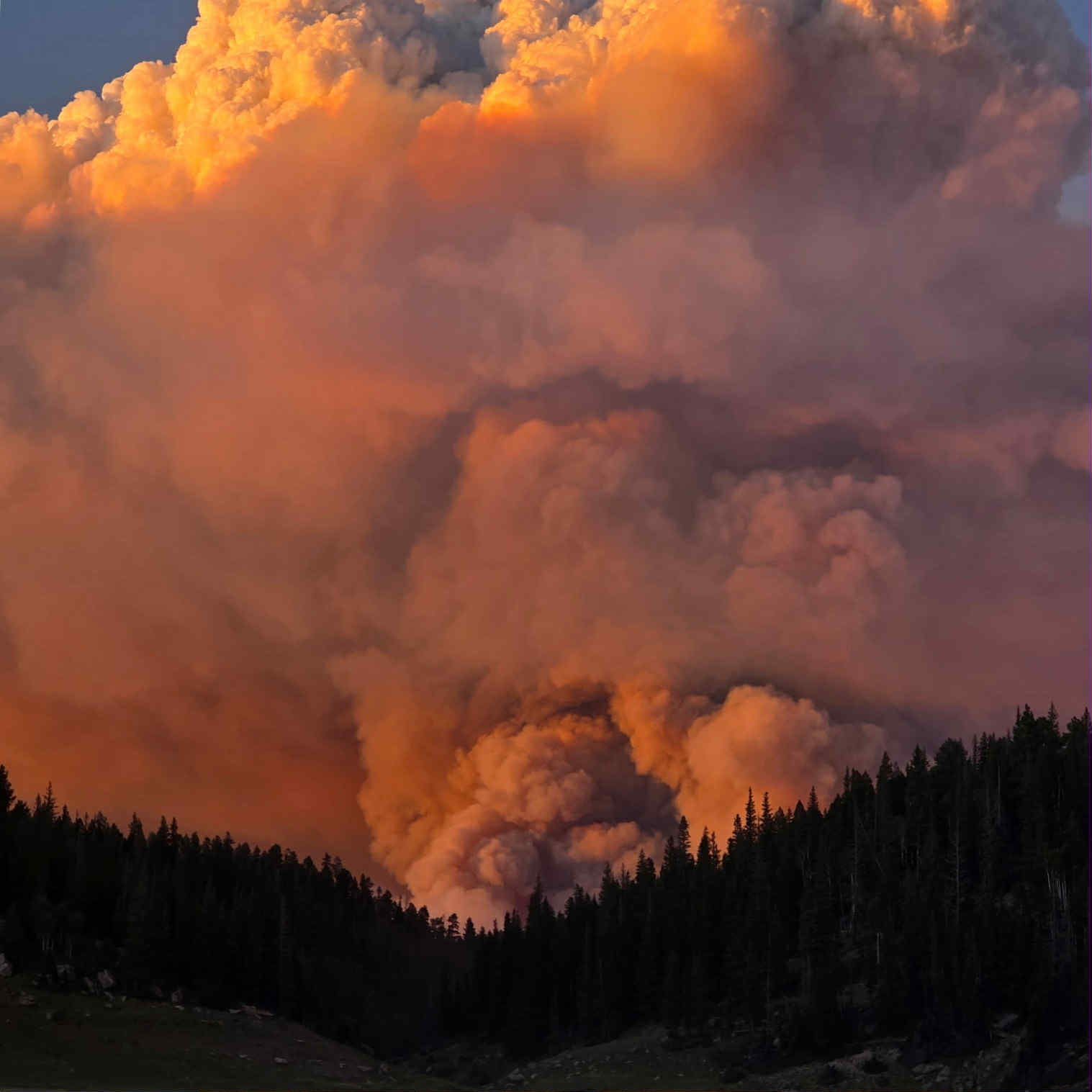ARIZONA – As wildfires rage across the state, including the Dragon Bravo Fire near the Grand Canyon National Park, Arizona’s private wildfire contractors are raising serious concerns about being shut out of the very fire response efforts they are qualified and contracted to support. Some are also raising legal questions, pointing to the Sherman Act and ARS Statutes.
Despite operating under the U.S. Forest Service’s Virtual Incident Procurement (VIPR) program, these private contractors say they are being overlooked in favor of public fire departments and districts—known as “cooperators”—who benefit from taxpayer funding and guaranteed reimbursements.
“They can have us ready all summer and never call,” said Derrick Holdstock, owner of Western Fire Resources, “We remain available all year, but this summer, we are not getting orders. We had 112 days on assignment over my three engines by this point last season. This year, we are only at 15 days, with 60% of those days being travel after being cancelled en route on 5 of 7 orders. Meanwhile, the cooperators are taxpayer-funded and receive priority dispatch. We do the same job, on the same fires, but we must bear all the financial risk with no guarantee of being ordered.”
Private contractors like Holdstock and David Bowden of Davissa Enterprises LLC are watching their engines sit idle during peak fire season. Bowden said, “You don’t get rich fighting fires. You get paid months later, meanwhile, you’ve put $20,000 on your credit card to mobilize.”
These private contractors operate under strict federal contracts that require them to cover all operational costs—fuel, payroll, insurance, and maintenance—with no base pay or standby stipend. Reimbursement can take 30 to 90 days after demobilization.
Meanwhile, public cooperators are fully funded through taxpayer-supported budgets. Their fire apparatus is publicly purchased, their personnel are salaried year-round, and all deployment costs—backfill wages, per diem if not supplied food, workman’s comp, payroll with disability and retirement, unemployment insurance, equipment repairs, and the holy grail of the 2 days off called R&R—are reimbursed by the incident. Private contractors receive only pre-diem out of the list above, but only if the incident does not supply food. They do receive water bottles and Gatorade, and in some cases, double-A batteries.
Public cooperators also earn additional profits through hourly engine rates, which range from $98 to $145, or $1,568 to $2,320 per day, after all reimbursable costs are accounted for.
An internal cost analysis comparing a Type 6 private contractor engine with a VIPR agreement at a median cost of $4,675/day with a cooperator engine, which can often exceed $6,000/day, highlights the discrepancy. Despite being more affordable, VIPR resources are frequently passed over.
Some resource orders have been marked with language like “Contractors Not Acceptable” or “Fed Only.”
On July 20, the Dragon Bravo Fire IC submitted a critical need ICS 209 form, requesting dispatch of 5 Type 3 or 6 engines, with preference for Federal or Cooperator personnel. Then on July 23, the Dragon Bravo Fire IC sent a 209 form to dispatch that stated a critical need for 8 type 6 engines Fed only. That request went to the Williams Interagency Dispatch Center (AZ-WDC).
Mountain Daily Star reached out to the Williams Interagency Dispatch Center (AZ-WDC) by email for comment, and they have not responded.
July 20 SWA ICS Daily Summary (209), Critical Resource Needs. In the column, Critical Resource Needs 48 Hours the need requests 5 type 3 or 6 engines Fed or Cooperator only. July 23 SWA ICS Daily Summary (209), Critical Resource Needs. In the column, Critical Resource Needs 48 Hours the need requests 8 type 6 engines Fed only.
According to a private contractor, once the critical need was announced, they were demobilized from the Dragon Bravo Fire and witnessed the arrival of Federal and cooperator personnel. The IAP indicates that several private contractor engines were demobilized, with 4-5 days remaining on their 14-day roll around the July 20- 23 timeframe.
According to the National Interagency Standards for Resource Mobilization Guide, “suppression requests are prioritized by the closest forces concept. Regardless of ordering agency, the resource that has the shortest timeframe to reach an incident should be mobilized, and a name request may not be honored if a closer, like resource, is available.”
The Dragon Bravo Fire brought this disparity to light. Following a visit from Governor Hobbs, fire orders seemed to exclude contractors outright. According to them, the exclusion has been occurring since the VIPR agreement prohibited contractors from using chainsaws except in emergency situations.
Private contractors argue that such practices amount to economic exclusion and may violate the Sherman Antitrust Act.
A recent federal antitrust case has reignited concerns over fair competition in wildfire response. In March 2025, contractor Kris Bird pleaded guilty to bid rigging and wire fraud alongside fellow contractor Ike Tomlinson, who admitted guilt in 2024. According to the Department of Justice, the two colluded to control the wildfire-fighting fuel truck market in the Forest Service’s Great Basin dispatch region, coordinating bids to undercut and exclude rivals. Officials, including DOJ Antitrust Chief Jonathan Kanter, pointed to the Sherman Act’s prohibition on monopolization as a core protection for American enterprise. Bird was sentenced in June 2025 to three months in prison, fined $24,000, and ordered to forfeit $1.5 million in proceeds from the fraudulent activity. DOJ officials emphasized that collusive practices erode trust in emergency response contracting and disadvantage honest vendors.
The case highlights broader concerns in Arizona, where public cooperators are increasingly viewed as competitors or “for-profit” businesses that sideline private contractors. Cooperators receive favor with dispatch priority and ride on public funding, such as taxes.
“There is no difference in my mind between the contract collusion case in Idaho and what is being done behind closed doors between cooperators and states, said Holdstock. In both cases, deals are made between two entities to gain a significant dispatch advantage at the expense of uninvolved entities, which results in higher profits being squeezed out of the American taxpayer while creating a de facto monopoly. Cooperators should be providing a service to the tax base that funds their existence. Instead, they are colluding with state agencies to secure priority dispatch to fires hundreds of miles away from that tax base so they may turn a profit.”
This concern may be addressed by Arizona Revised Statute § 41-2752, which prohibits state agencies from offering goods or services to the public that compete with private enterprises unless specifically authorized to do so by law. Although certain exceptions apply, wildfire suppression by public cooperators—particularly when dispatched in lieu of available contractors—raises legal and ethical questions about whether cooperators are competing unlawfully under the guise of public service, rather than as a for-profit business.
Legal experts emphasize that ARS § 41-2752 contains no general exemption for “public service.” The statute is designed to prevent state agencies from displacing private businesses unless they fall within clearly defined legal exceptions. Fire departments or districts acting as cooperators—while not explicitly exempt—receive compensation for expenses, backfill, and profit beyond costs when responding to wildfires, which could meet the statutory definition of “profit.” This creates a potential conflict with the law’s intent, as the delivery of fire suppression services overlaps with services offered by Arizona private wildfire contractors, some of whom are being excluded from the marketplace.
State Representative Walt Blackman has called for urgent reforms. In a July 24 press release, he criticized dispatch policies that favor imported cooperator crews over Arizona-based contractors.
“We should be using every trained and equipped engine in the state—but instead, we’re bypassing local crews and importing more expensive resources from out of state,” said Rep. Blackman.
Rep. Blackman urged Governor Hobbs to audit dispatch logs and review the contract framework disadvantaging private vendors.
The system’s structural bias is reinforced by the 2025 Southwest Area Interagency Standards for Resource Mobilization Guide and the Arizona Wildland Fire Equipment Mobilization Plan, which either prioritize cooperators or exclude contractors entirely in many scenarios.
“When a public cooperator gets sent to a fire, it’s backed by infrastructure,” said a U.S. Forest Service dispatcher. “When a private contractor goes, it’s their mortgage, their diesel, and their personal risk.”
Holdstock warns of long-term impacts: “The present situation that many Region 3 private contractors are in could lead to a serious problem in the future of the Region 3 wildland firefighting force. Without reform, we will lose these contractors. And if we hit a National PL5, the nation will feel it.”
Private contractors are required to maintain compliance year-round, investing in inspections, training, and equipment even while sitting idle. Yet they are often overlooked when local or regional fires emerge. Local private contractors have a unique understanding of the terrain and fire behavior within their service area. It’s where they live, pay taxes, and have a vested interest in local fire protection.
The Dragon Bravo seems to be “breaking bad’ coming in at over 77,000 acres as of July 29. The expansion of the fire that burned down the historical North Rim Lodge, particularly when resources are left idle, is concerning.
Adding insult to injury, some agencies reportedly leave resource orders unfilled rather than assign them to contractors—even when those contractors are available and nearby. The net effect is the creation of a de facto monopoly for government agencies, excluding lower-cost private sector solutions and increasing the taxpayer burden.
As Arizona’s fire season intensifies, so does the debate. At its core, the question is whether the current system prioritizes efficiency, fairness, and fiscal responsibility, or protects institutional interests at the expense of Arizona’s readiness.
Until that answer changes, private contractors may continue to fight not just getting to a fire, but an uphill financial, legal, and bureaucratic battle for survival.




